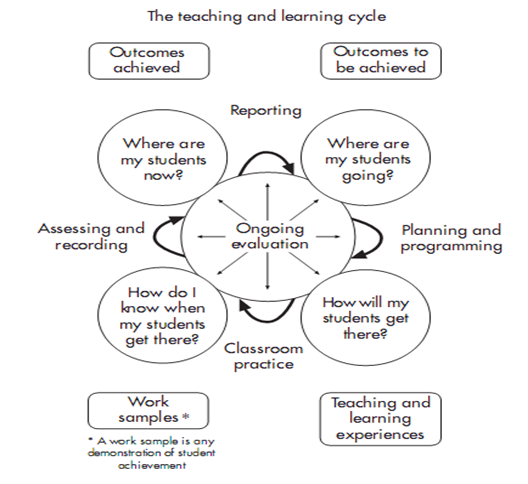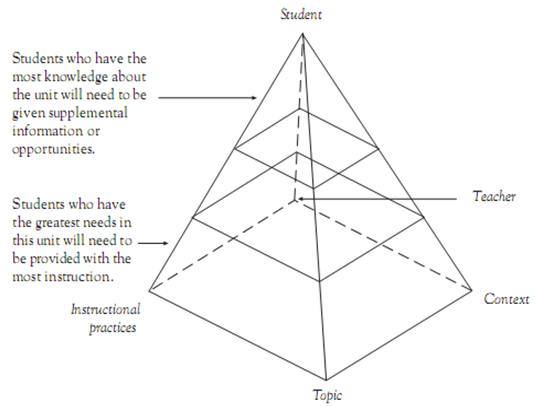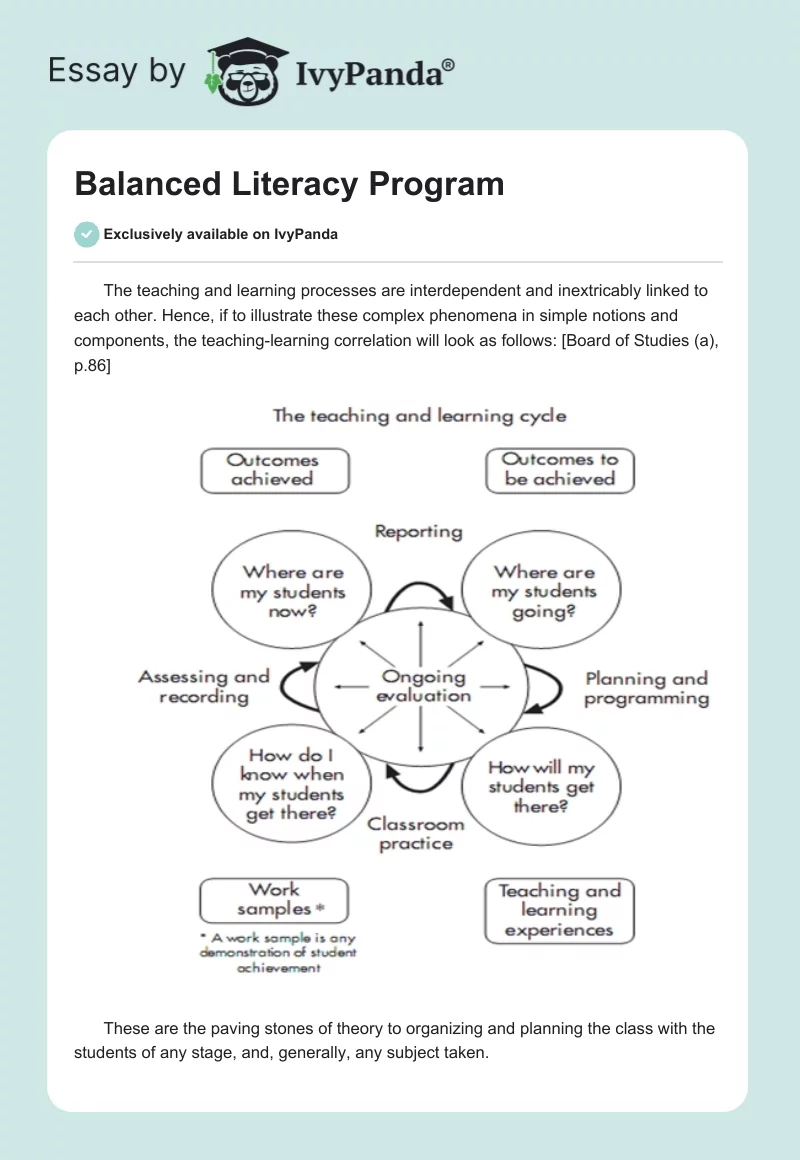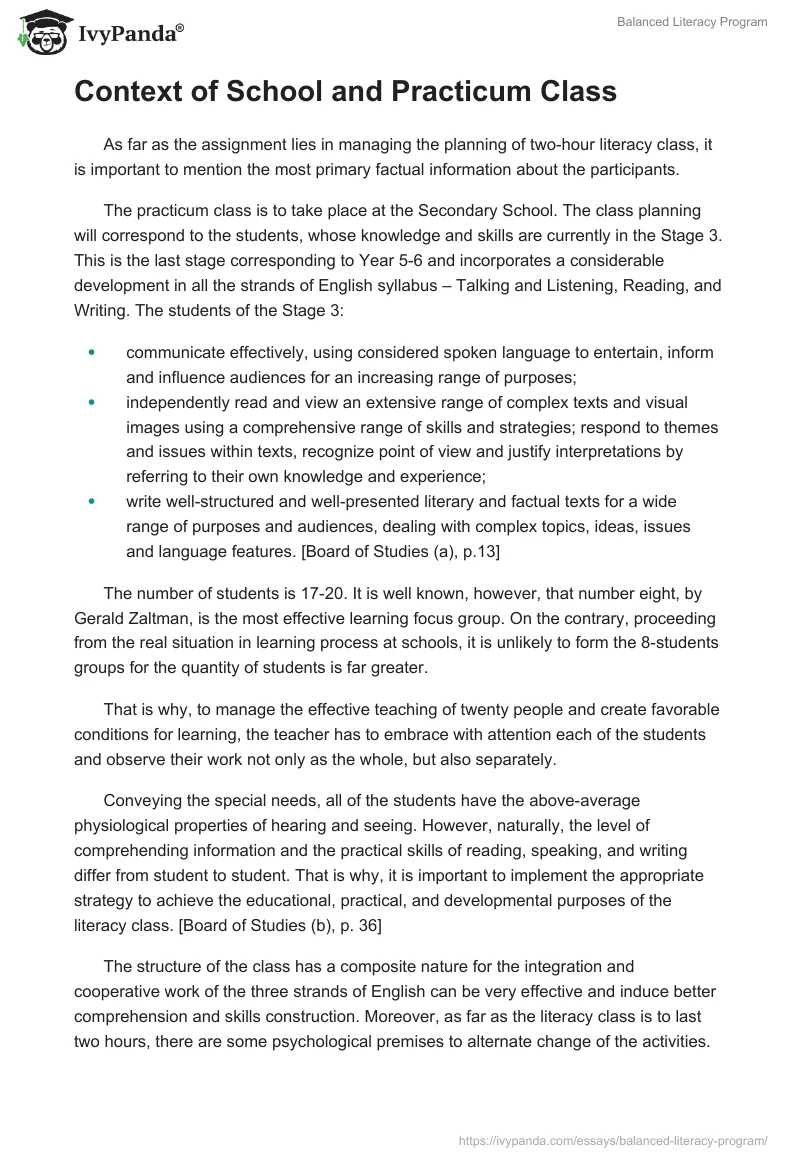The teaching and learning processes are interdependent and inextricably linked to each other. Hence, if to illustrate these complex phenomena in simple notions and components, the teaching-learning correlation will look as follows: [Board of Studies (a), p.86]

These are the paving stones of theory to organizing and planning the class with the students of any stage, and, generally, any subject taken.
Context of School and Practicum Class
As far as the assignment lies in managing the planning of two-hour literacy class, it is important to mention the most primary factual information about the participants.
The practicum class is to take place at the Secondary School. The class planning will correspond to the students, whose knowledge and skills are currently in the Stage 3. This is the last stage corresponding to Year 5-6 and incorporates a considerable development in all the strands of English syllabus – Talking and Listening, Reading, and Writing. The students of the Stage 3:
- communicate effectively, using considered spoken language to entertain, inform and influence audiences for an increasing range of purposes;
- independently read and view an extensive range of complex texts and visual images using a comprehensive range of skills and strategies; respond to themes and issues within texts, recognize point of view and justify interpretations by referring to their own knowledge and experience;
- write well-structured and well-presented literary and factual texts for a wide range of purposes and audiences, dealing with complex topics, ideas, issues and language features. [Board of Studies (a), p.13]
The number of students is 17-20. It is well known, however, that number eight, by Gerald Zaltman, is the most effective learning focus group. On the contrary, proceeding from the real situation in learning process at schools, it is unlikely to form the 8-students groups for the quantity of students is far greater.
That is why, to manage the effective teaching of twenty people and create favorable conditions for learning, the teacher has to embrace with attention each of the students and observe their work not only as the whole, but also separately.
Conveying the special needs, all of the students have the above-average physiological properties of hearing and seeing. However, naturally, the level of comprehending information and the practical skills of reading, speaking, and writing differ from student to student. That is why, it is important to implement the appropriate strategy to achieve the educational, practical, and developmental purposes of the literacy class. [Board of Studies (b), p. 36]
The structure of the class has a composite nature for the integration and cooperative work of the three strands of English can be very effective and induce better comprehension and skills construction. Moreover, as far as the literacy class is to last two hours, there are some psychological premises to alternate change of the activities.
The reason for this is the fact that human brain is only able to effectively perceive information performed in one particular way during maximum 20 minutes. After each 20 minutes it is highly desirable to change the kind of activity. [Literacy: Reading, Writing and Children’s Literature (Fourth Edition), p.220]
Outcomes and Indicators
Hence, the class will deal with the three outcomes (Talking and Listening, Reading, Writing). Concerning each outcome, I focus on the following indicators:
Talking and Listening:
- to perform the idea orally, give reasonable proofs to it in order to persuade the classmates in its truthfulness;
- to listen and note key ideas and information from the recording;
Reading:
- to take part in brainstorming in order to structure and organize the information following the reading of texts, to make sensible guesses of what the text may be about;
- to read and comprehend the basic written text;
Writing:
- to create a narration using the key ideas written down earlier;
- to consolidate the knowledge about writing some irregular words and to define the semantics of new words.
Context of Literacy Session
The literacy session will consider the topic “The Sleep”. This class is the constituent of the general covering theme “Wellbeing”, which includes the topics about healthy way of life, nutrition, and other educational issues. The topic will enable the students to acquire profound knowledge about sleep-phenomenon and define personal preferences of sleeping.
Therefore, to the literacy development there is a general educational purpose of the class, which states to teach the students facts about human physiology.
What is more, the topic should sound comparatively familiar to the majority of the students (they may have studied it during biology classes) for the most effective skills and knowledge acquisition takes place only when the 90% of the whole information is already known. [Programming and Strategies Handbook, p.35]
Planned Teaching and Learning Sequence
As one may infer, the class consists of the three parts, which traditionally include introduction, main part, and conclusion. Introduction is as important, perhaps, even more to the flow of the class and positive atmosphere between the teacher and students.
To introduce the topic of the class to the students I shall use the ‘visual’ material. The image will force the students to raise a discussion what is the main idea of the picture. During this discussion, the teacher will direct the vector of it in order to turn the students to the desirable point.
While doing this, students will learn to express their point of view explicitly and laconically for this discussion will last no longer than 10 minutes. Than, to activate some background knowledge, the teacher will ask what sleep is, what are students’ personal preferences about sleep, and what more they would like to know about this phenomenon. This would also last approximately 10-15 minutes.
The main part of the class will be dedicated to the text and different activities built around it. The composite text about “How Much Sleep Do I Need” is situated on the Internet-page and performs the excellent set of main information that a student of Year 5-6 would require.
As one may observe, there is also an option of audio-recording, which is going to be used at the first place. Therefore, the students will be asked to take some sheets of paper and, while listening to the first text abstract, to put down the main facts and ideas on the topic “Why Aren’t We Getting Enough Sleep”. The recording will be listened to twice so as the students could grasp the information in a proper way.
The whole activity will last about 15-20 minutes. The next activity will be connected to the latter and the task will lie in building a short narration on the basis of the key points written down earlier. This activity is aimed at developing overall writing skills, the ability to make sentences and ideas cohesive, and put the correct punctuation signs in them.
The students will have approximately 15-20 minutes to complete the task and hand in their papers. Further, either printed out, or on computers that each of children would have, the title of the text will be the theme for brainstorming ideas. Indeed, on seeing the question “Why Sleep Is Important?”, the students will be engaged into the production of ideas and possible suggestions concerning the vitality of sleep for a human.
This activity will last about 20 minutes. On managing the brainstorming activity, the class plan switches to the reading itself. The students read in turns, paragraph by paragraph and the teacher follows them. Whether there are mistakes in pronunciation of words, their position or some others, the teacher gives a chance to the student to correct him- or herself using the PPP-strategy. [Programming and Strategies Handbook, p. 68].
This tutoring procedure supports students as they are reading aloud and incorporates Pause Prompt Praise. The unknown words to the students should be undoubtedly explained so that their semantics was clear to each of them. During the reading process it is important that the teacher also pointed out the spelling of the irregular words. The teacher should also put accent on the punctuation marks used in the text. Reading the text abstract will take 30 minutes.
After that, in order to consolidate the information introduced, the students are welcome to watch the 9-minutes video about Dr.Mercola’s tips on getting better night’s sleep. During watching the video, students point out the most important, as they may define, piece of advice suggested by Doctor. Hereafter, students perform their ideas and argument why they have chosen exactly this or that tip. This activity would also last about 20 minutes.
Finally, there comes the moment of the conclusion, where the teacher asks the students to sum up what they have done today at this class and what new they have found out. The teacher tells the home task (sometimes not obligatory), which would require some creative skills.
Specific Details of Differentiation

There is no doubt there should be an individual approach to each of the students who are in need of higher level of support. That is why it is important to create a fully flexible class planning that could be easily accustomed to the students with different needs.
The easiest example would be the introduced text, both in recording, and in written form, very convenient for the students with either sight, or hearing problems. There is a scheme, which also illustrated the relations in class.
Details of Assessment
The students are being assessed during the class considering several factors. The first factor is the ability to interact and staying enthusiastic. The second factor is the reading assessment and the reaction on the PPP-strategy. And, at last, the final factor is the written narration, which is being checked by teacher after the class.
A Series of Questions and an Evaluation of their Effectiveness
Like in the proposed scheme “The Teaching and Learning Cycle”, there are definitely some basic points and questions to be asked, such as:
Where are my students going?
The answer to this question is outlined earlier when defining the purposes in all the outcomes – Talking and Listening, Reading, and Writing.
How will my students get there?
The answer is the whole class planning which has been designed to correspond to the objectives and purposes of the class.
How do I know when my students get there?
At the end of the class the teacher asks the students to sum up all the information and knowledge acquired at the class.
Were the means of introducing the material appropriate?
As far as the activities were constantly changing and the class planning had composite characteristics, there was naturally used some technical supply. And, it should be pointed out, that the latter was the main premise for the effective and interesting information acquisition.
Generally, the class planning and the class flow are considered effective for the aims set have been achieved. This was followed by students’ increasing interest in the topic, when, by enriching their knowledge about human physiology, they are acquiring the skills in the three stances of English.
Works Cited
Board of Studies (a), NSW English K-6: Syllabus. Sydney, NSW: Board of Studies. 1998. Web
Board of Studies (b), NSW English K-6: Modules. Sydney, NSW: Board of Studies. 1998. Web.
Board of Studies (c), NSW English K-6: Worksamples. Sydney, NSW: Board of Studies. 1998. Web.
Programming and Strategies Handbook NSW Department of Education and Training. 1998. Web.
Winch, G., Ross Johnston, R., March, P., Ljungdahl, L., Holliday, M. Literacy: Reading, Writing and Children’s Literature (Fourth Edition). Melbourne: Oxford. 2010. Chapter 12, pp. 220-245.


